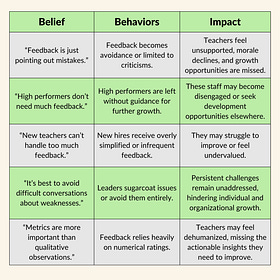If feedback is supposed to be a gift, why do teachers so often feel like they’re unwrapping a pair of socks? Good feedback should be specific, actionable, and supportive. But in schools across the country, teachers hear vague, unhelpful, or downright demoralizing feedback that does more harm than good. Let’s dive into the top five worst offenders and why they fail—plus what to say instead.
1. "You Should Smile More."
Ah, the classic. This feedback is not only patronizing, but it also completely misses the mark on effective teaching. Smiling isn’t a teaching strategy; it’s a facial expression. While warmth and approachability matter, research shows that clear expectations, engaging instruction, and strong relationships—not forced grins—build positive classroom cultures (Marzano, Marzano, & Pickering, 2003).
Why It’s Bad Feedback:
It’s subjective and rooted in personal preference rather than pedagogy.
It reinforces the outdated idea that teachers should prioritize being likable over being effective.
It ignores the fact that some of the best teachers don’t walk around beaming 24/7, but they do command respect and connection.
What to Say Instead: “Students respond well to warmth and clear expectations. I noticed they were more engaged when you checked in with them individually—how might we incorporate more of those moments?”
2. "You Need to Work on Your Classroom Management."
Well, sure. But how? Telling a teacher they need to work on classroom management is like telling a pilot they need to fly better. Effective feedback breaks down what’s happening, why it matters, and how to improve. Research suggests that feedback is most effective when it’s targeted at a specific behavior, not just a broad category.
Why It’s Bad Feedback:
It’s too vague to be useful.
It doesn’t acknowledge what’s already working.
It implies failure without a roadmap for success.
What to Say Instead: “When students were working in groups, I noticed some off-task behavior. One strategy that could help is setting clearer expectations before releasing them to work. Here’s what I mean. First, you square up and stand still. You give them the attention getting signal. Then, you tell them what you want them to do with their bodies, mouths, and brains. Let’s try it.”
3. "The Objective Needs to Be on the Board."
Objectives matter, but writing them on the board doesn’t automatically make them meaningful. Research on visible learning (Hattie, 2009) shows that what truly impacts student understanding is when teachers explicitly connect objectives to learning activities and help students see their relevance.
Why It’s Bad Feedback:
It confuses compliance with effectiveness.
It assumes students will engage with an objective simply because it’s visible.
It ignores the broader question of whether students understand what they’re learning and why it matters.
What to Say Instead: “How do students know what success looks like in this lesson? How do you check in with them about their progress toward that goal?”
4. "You Should Differentiate More."
Ah yes, just ‘differentiate more.’ Like it’s an easy toggle switch. Differentiation is essential, but it requires time, strategy, and resources. Saying “differentiate more” without specifying where and how is overwhelming and unhelpful.
Why It’s Bad Feedback:
It doesn’t acknowledge what differentiation is already happening.
It implies the teacher is failing subsets of students without offering solutions.
It can feel like an impossible demand rather than a strategic improvement.
What to Say Instead: “I noticed a few students finishing quickly while others were struggling. Would you like to explore ways to provide extension activities for when they finish the independent practice?”
5. "You Just Need to Build Relationships."
Strong teacher-student relationships are foundational to learning (Cornelius-White, 2007), but this feedback is so broad it’s nearly meaningless. What kind of relationships? How do we build them? And what if the teacher is already trying?
Why It’s Bad Feedback:
It assumes relationship-building is a one-size-fits-all process.
It can feel dismissive, especially to teachers already working hard on this.
It lacks actionable strategies.
What to Say Instead: “I noticed your students responded really well when you asked about their weekend. Have you found that certain check-in routines work better than others?”

AI and Teacher Feedback: What You Can and Cannot Do
AI can be a helpful tool in many areas, but giving teacher feedback isn’t one of them. Teachers know when you are inauthentic. If you’re using AI to generate feedback wholesale, just don’t. It comes off as robotic, impersonal, and often misses the nuance of classroom interactions.
That said, AI can be useful for small shortcuts, like helping you remember the name of a strategy (“What’s the name for the move where you call on a kid without their hand up?” – That’s cold calling, by the way). You can use AI for reference, brainstorming, or summarizing research, but never let it replace your professional judgment or the genuine human connection teachers deserve in feedback.
This felt important to say.
Give Better Feedback, Get Better Teaching
If we want to support teachers in growing their practice, we need to ditch the vague, compliance-driven feedback and replace it with targeted, actionable insights. Great feedback is:
Specific: Describes what was observed, not just a general category.
Actionable: Offers concrete steps to improve.
Supportive: Acknowledges what’s working and builds from there.
Let me know! What’s the worst feedback you have heard?
Belief Inventory Research Guide
In the last post, I gave you a belief inventory for feedback because we know that beliefs drive action.
Communicating beliefs through feedback
A teacher's mindset influences their approach to instruction, classroom management, and student interaction. Like all humans, teachers' interactions with others, their environment, and their experiences influence the thought patterns that drive their daily actions. From promoting school core values to encouraging someone out of their shell, all leaders …
Your beliefs about feedback are limiting your impact
Feedback is one of the most powerful tools for improving organizational performance, engagement, and innovation. Yet, misconceptions and limiting beliefs about feedback can prevent leaders from maximizing their potential.








As a teacher, can I just say how much I love the advice you give to instructional coaches or administrators in this post? I love that you explain what the bad feedback is, WHY it is bad AND what to do instead.
One of the worst piece of feedback I ever got was my 3rd or 4th year teaching 11th grade U.S. history. The administrator (whose background was not in history) commented, "I would have liked to see something other than students doing a worksheet." As Jennifer Gonzalez observed in her oldie but goodie post, "Frickin' Packets" on Cult of Pedagogy (https://www.cultofpedagogy.com/busysheets/), the term "worksheet" or "packet" can be applied to virtually anything printed on an 8 1/2 X 11 sheet of paper.
The "worksheet" in question was a 3 page "packet" that took all the information I had used the year before in a lecture on Colonial America and turned it into work that students did in pairs that involved 1. making inferences and drawing conclusions from two images (paintings), 2. making a comparison between two bar graphs, 3. a brainstorm activity, 4. a chronology activity and 5. an analysis of three primary sources. I still have a copy of that original. I liked it so much that I adapted it for the 7th graders I taught 20 years later.
Wow, this article was filled with so much practical advice for those of us who work with teachers. I loved how you broke down what coaches should say instead of what is commonly said. Your replacement feedback was so clear and actionable. Most importantly it will positively impact teachers and ultimately students